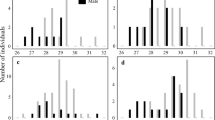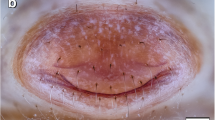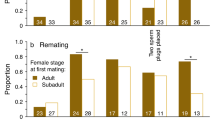Abstract
Female sexual receptivity was studied in F1 laboratory-reared Glossina pallidipes Austen, 1903 originating from Nguruman in the Rift Valley of Kenya. Females mated as early as 6 days old but reached peak receptivity at 9–13 days old (60–80%). Females did not immediately mate with more than one male. The mean spermathecal value (MS V) was highest between 7 and 14 days of age, and declined thereafter. The duration of copulation was comparatively short (mean = 24 min), and did not vary significantly with age. High female receptivity corresponded with maturity of ovariole A, which reached maximum length at an age of 10 days. These results are discussed in relation to mass rearing of G. pallidipes.
Résumé
La receptivité sexuelle femelle a été étudiée chez des Glossina pallidipes, Austen 1903, élevées en laboraoire, et appartenant à une souche provenant de Nguruman dans le Rift Valley, au Kenya. L’accouplement des femelles a lieu dès le 6 ème jour d’âge, mais le pic de creceptivité femelle est atteint entre 9 et 13 jours d’âge (60 a 80 %). Les femelles ne s’acouplent pas immédiatement avec plusd’un mâle. La valeur spermathécale moyenne est plus élevée entre 7 et 14 jours d’âge et decroît au-delà. La durée de copulation est comparativement courte (moyenne = 24 mn), et ne varie pas significativement avec l’âge. Le maximum de receptivité femelle correspond à la maturite de l’ovariole A, qui atteint une longueur maximale à 10 jours d’âge. Ces résultats sont discutés en rapport avec élevage en masse de G. pallidipes.
Similar content being viewed by others
References
Chaudhury M. F. B., Dransfield R. D. and Golder T. K. (1984) Reproductive biology of Glossina pallidipes. Twelfth Annual Report, ICIPE.
Craig G. B. (1967) Mosquitoes: Female monogamy induced by male accessory gland substance. Science 156, 1499–1501.
Etten J. Van (1981) A comparison of the performance of laboratory colonies of Glossina pallidipes Austen from two allopatric populations in Kenya. Insect Sci. Applic. 1, 177–183.
Foster W. A. (1976) Male sexual maturation of the tsetse flies Glossina morsitans Westwood and G. austeni Newst. (Dipt. Glossinidae) in relation to blood feeding. Bull. entomol. Res. 66, 389–399.
Gillott C. and Langley P. A. (1981) The control of receptivity and ovulation in the tsetse fly, Glossina morsitans. Physiol. Entomol. 6, 269–281.
Jaenson T.G.T.(1978)Reproductivebiology of the tsetse Glossina pallidipes Austen (Diptera, Glossinidae) with special reference to mating behaviour. Thesis University of Uppsala, Sweden.
Jaenson T. G. T. (1979) Mating behaviour of Glossina pallidipes (Diptera, Glossinidae): Duration of copulation, insemination and fecundity. Entomol. Exp. Appl. 26, 1–12.
Jaenson T. G. T. (1980) Rearing of Glossina pallidipes using membrane feeding technology. Entomol. Exp. Appl. 27, 102–104.
Jordan A. M. (1958) The mating behaviour of females of Glossina palpalis (R-D) in captivity. Bull. entomol. Res. 49, 35–43.
Langley P. A. (1977) Physiology of tsetse flies (Glossina spp.) (Diptera: Glossinidae): a review. Bull. entomol. Res. 67, 523–574.
Langley P. A. (1989) Laboratory colonization of the tsetse fly Glossina pallidipes Austen (Diptera: Glossinidae) using an in vitro feeding method. Bull. entomol. Res. 79, 429–435.
Langley P. A., Coates T. W. and Carlson D. A. (1982) Sex recognition pheromone in the tsetse fly Glossina pallidipes Austen. Experientia 38, 473–474.
Leegwater Van der Linden M. E. (1982) Receptivity, ovulation and larviproduction in Glossina pallidipes, related to mating at various ages. Entomol. Exp. Appl. 32, 91–98.
Leegwater Van der Linden M. E. (1983) The rearing of the tsetse fly Glossina pallidipes Austen. Thesis, University of Amsterdam.
Leegwater Van der Linden M. E. and Tiggelman E. P. M. (1984) Multiple mating and inseminating potential of Glossina pallidipes. Entomol. Exp. Appl. 35, 253–294.
Manning A. (1962) A sperm factor affecting the receptivity of Drosophila melanogaster females. Nature 194, 252–253.
Manning A. (1966) Sexual behaviour. In Symp. R. Entomol. Soc. London, 3 (Edited by Haskel P. T.), pp. 59–68.
Mellanby K. (1936) Experimental work with the tsetse fly, Glossina palpalis in Uganda. Bull entomol. Res. 27, 611–633.
Nash T. A. M. (1955) The fertilisation of Glossina palpalis in captivity. Bull. entomol. Res. 46, 3567–3568.
Ochieng R.S., Otieno L.H. and Banda H.K. (1987) Performance of the tsetse fly Glossina pallidipes reared under simple laboratory conditions. Entomol Exp. Appl. 45, 265–270.
Odhiambo T. R. (1968) Influence of age and feeding on the success of mating in a tsetse fly species. Nature 219, 962–963.
Riemann R. G., Moen D. J. and Thorson B. J. (1967) Female monogamy and its control in houseflies. Insect Physiol. 13, 407–418.
Rogers A. (1972) Studies on the mating of Glossina pallidipes Austen. 1: the age at mating. Ann. Trop. Med. Parasitol. 66, 515–523.
Rogers A. (1973) A method for gauging the frequency of multiple mating of female Glossina pallidipes in the field. Trans. R. Soc. Trop. Med. Hyg. 67, 299.
Romoser W. S. (1973) The Science of Entomology. Macmillan Publishing Co., Inc. New York.
Saunders D. S. and Dodd C. W. H. (1972) Mating, insemination and ovulation in the tsetse fly, Glossina morsitans. J. Insect Physiol 18, 187–198.
Tobe S. S. and Langley P. A. (1978) Reproductive physiology of Glossina. Annu. Rev. Entomol. 23, 283–307.
Wall R. (1989) The roles of vision and olfaction in mate location by males of the tsetse fly Glossina morsitans morsitans. Med. Vet. Entomol. 3, 147–152.
Willett K. C. (1953) The laboratory maintenance of Glossina. Parasitology 43, 110–130.
Author information
Authors and Affiliations
Rights and permissions
About this article
Cite this article
Davies-Cole, J.O.A., Chaudhury, M.F.B. Mating Efficiency in Females of Glossina Pallidipes. Int J Trop Insect Sci 11, 355–361 (1990). https://doi.org/10.1017/S1742758400012777
Received:
Revised:
Published:
Issue Date:
DOI: https://doi.org/10.1017/S1742758400012777
Key Words
- Glossina pallidipes
- duration of copulation
- sexual receptivity
- ovarian development
- mean spermathecal value




